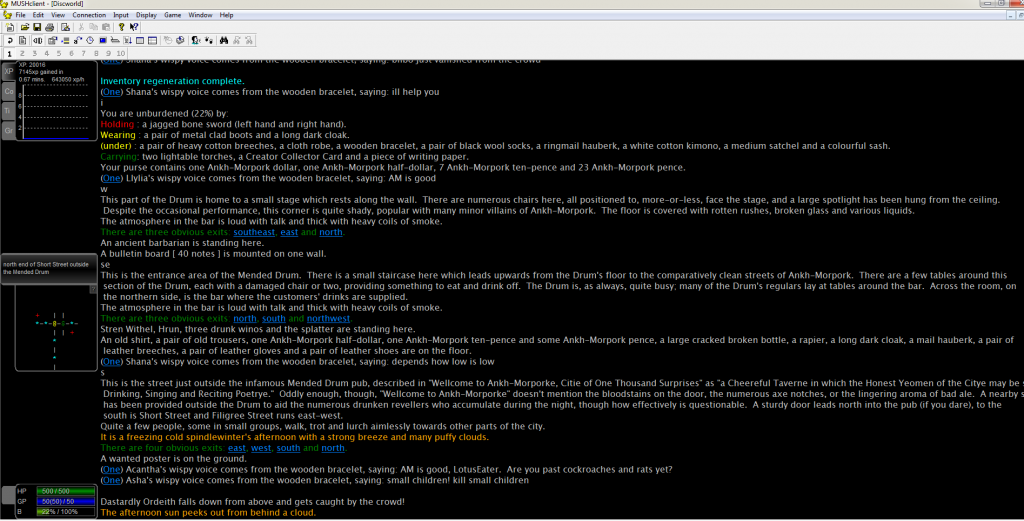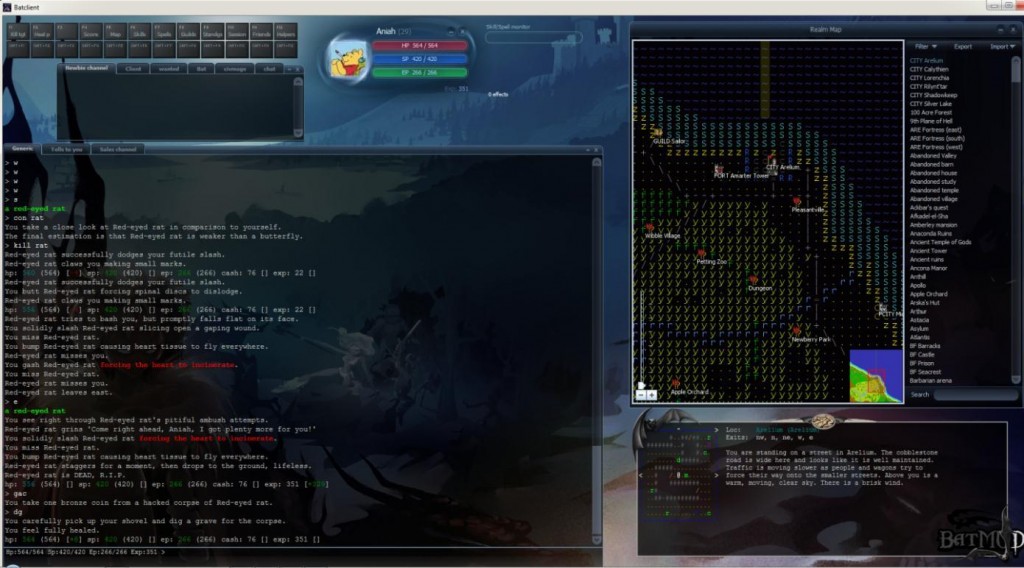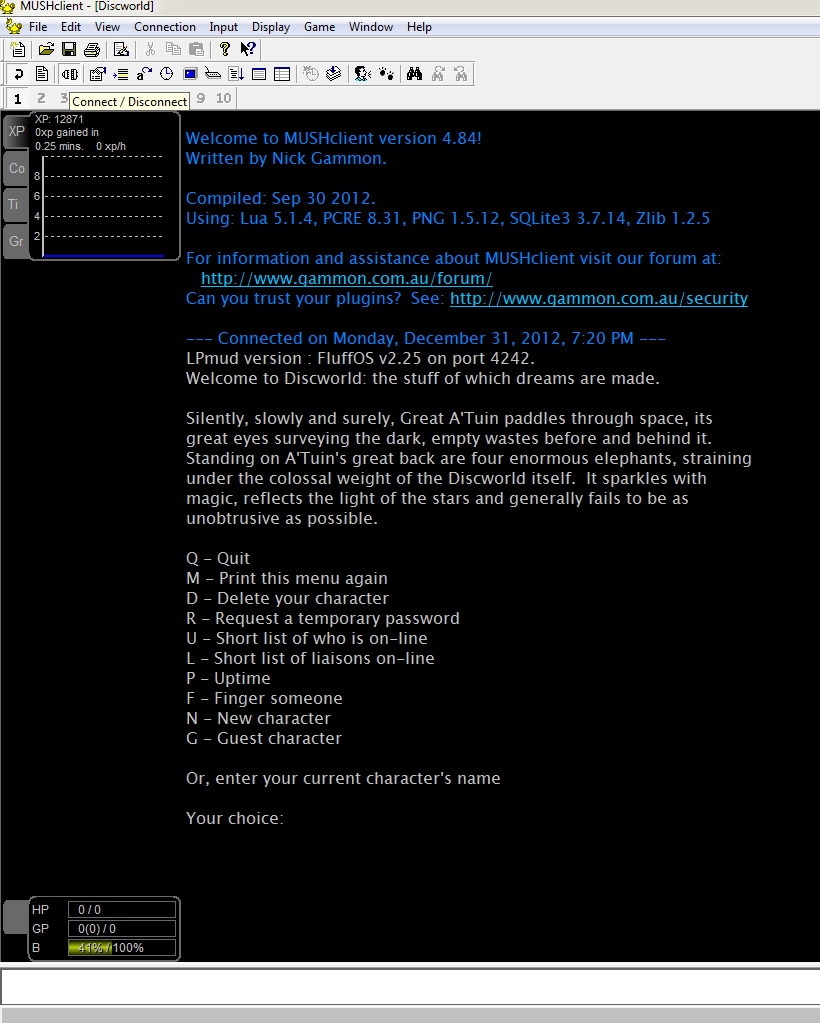Emily Lutringer is a very experienced gamer who specializes in MMOs and other online games. One such type of game is MUDs, which have always fascinated me, personally, being that they’re kind of the “way more interesting grandfather of MMOs”. Anyway, I asked Emily to write me an article on the subject to introduce my readers to the games, and she did! So here it is – thanks so much to Emily for her great work. – Keith
In the end, I always return to MUDding. Fancy, flashy new games distract me for a while – long enough to forget what in the world I was doing in any particular MUD. Eventually, those games bore me, and I return, seeking out both nostalgic MUDs of my youth as well as new ones. But how can a text-based ASCII online game of the early 1990s, completely free and completely run, coded, and designed by volunteers, possibly compete for my attention in the graphical games and MMO worlds?
The movie is never as good as the book. Well, 98% of the time, anyways. A MUD is the book of the online multiplayer gaming scene. It’s where it all began.
Modern MMOs have even dropped the -RPG suffix for the most part, simply because they have become so dumbed down to appeal to large audiences that they have left all the finer points (and the most fun and interesting points) out.
MUDs are a labor of love. Instead of churned out by code monkeys, they are artisan-crafted, filled with creativity and individuality. MUDs are the smart people’s MMO; the hackers and coders, writers, artists and scientists. It is a unique blend of art, science, mathematics, and gaming. And this is apparent in its structure, causing those who don’t have the intelligence, or patience to understand its system to quickly weed out. For all of us who complain about the idiot communities of games like WoW, we can seek refuge in the world of MUDs.
MUD – Not Your Average Mix of Dirt and Water
MUD stands for Multi-User Dungeon. Most MUDs are RPG style games, which exist in a persistent world where you play real time with other people. Just like in MMOs, there are monsters to fight, quests to solve, parties to form, crafting, and even epic PvP (on MUDs, this is usually called PK for Player Killing). The primary difference that you will notice is that there are no graphics. MUDs are entirely text-based, although many use ASCII for simple graphics and mapping. In fact, the early MMOs were called “graphical MUDs”. Everquest was so closely styled after a MUD that they even had to prove that their code was original. Ultima Online is another popular MMO which was based very closely on MUD gameplay. As time went on, MMOs started looking and feeling very different from the old MUDs, but they all still retain the basic structure and elements of their forefathers. Most MUDs are 100% free to play.
MUDs come in various styles, and with many different features, and there is a MUD to suit almost anyone’s tastes – from roleplaying mandatory, to permadeath, to hardcore PK (PvP), from fantasy, to sci-fi, to even X-rated adult MUDs. There are usually a very large number of classes and races to choose from, and enormous amounts of character customization options. There are even MUDs which have completely done away with levels and classes, and instead, you gain in power by increasing your skills – in whichever way you choose, making your character uniquely your own. Usually, there is some system in place which allow players to own and design their own homes, ships, or even entire cities.
You move around using directional commands such as “n” for north, “se” for southeast, etc. Sometimes room descriptions contain valuable information – such as clues for a quest, or objects you can interact with, which are not immediately apparent. Usually the most important things such as other players, NPCs, monsters, and items on the ground are highlighted with color and below the room description to make it easy to see those things at a quick glance.
Here is how some MUDs look in-game:


MUDs began out of the beginnings of the internet, starting first in the realms of games on dial-up BBSes and then growing into their own coding languages and servers. The first MUD was developed in the mid-1980s, but MUDs didn’t really take off on their own until about 1990. Amazingly, many of the MUDs you see around today have been in existence since the early 1990s continuously, with various updates and improvements made over the years. You can usually even find a few players who have been playing that MUD since it’s birth – over 20 years in some cases!
There are many different styles of coding systems. When you see things like LPMud, DikuMUD, MUSH, MOO, and so on, that is essentially referring to the type of coding language as well as the basic engine of the game. Some codebases are more suited to different styles of games – Diku and its derivatives, for example, are known to be great systems for hack-and-slash type games.
Who Should Play MUDs – and Who Shouldn’t
MUDs take work from the player. These are not passive, absent-minded games. You must engage in the story, in your character, and in the world. Each game has its own syntax and commands you must learn. It requires lots of reading. It can get tedious. The player must have patience, as things take much longer to get done in a MUD than in a MMO. Good grammar is important, as is proper netiquette.
There is very steep learning curve, which can be difficult and frustrating, but the result is an immersive experience brimming with creativity and imagination. Many times I have thought, “huh, I wonder if I can do this”… and I could. Wield an octopus and slap orcs around with it? Sure. Pick mushrooms in the forest, eat them and hallucinate? Yup. Fly, swim, sail, open portals to demonic dimensions, or play the lute? Of course. And when “smile” and “wave” just don’t cut it, there are thousands of emotes built into the game to express yourself. One of the major benefits of not having graphics is that the game can do just about anything it wants without having to visualize it for you or have huge amounts of code to do something. Additionally, MUDs tend to have very complex and intricate storylines, and many MUDs even alter their world based on how players interact with it. Too many people cutting down trees? Now that forest is a desert.
Interesting places, a sense of real adventure, a tight community, and just about any scenario and environment you can imagine and a million ways to accomplish any given task – these are the essential facets of MUDding.
If you have the patience and time, and a curiosity which outweighs slower gameplay and the steep learning curve, and are interested in a smarter, richer, deeper online multiplayer experience, you should play MUDs. Or, if you are simply nostalgic for the early days of the internet. If you do not have the above qualities, then you shouldn’t play MUDs (although I still suggest trying it out a few times to just learn about how they work and to make yourself a better person).
How to connect to a MUD and start playing
First, you need a client. It’s possible to use plain old boring telnet if you like, but that’s a really limited experience. I suggest using MUSHclient – it’s completely free, has lots of features and customizations, and a strong community and forums if you need help. Don’t be turned off by the Windows ’95 look – most MUD clients are rather outdated, but they still work great. Another popular client is Zmud – or its more modern reincarnation as Cmud. These are paid apps, but for many serious MUDers they are simply the best clients around. They do have very advanced features and tools, but, most of that is not necessary, especially if you are new to MUDing. Additionally, many MUDs now have the option to connect using Flash through their websites, so you don’t need to download a client at all. And other MUDs have custom clients which are designed specifically for their MUD and can really take the whole experience up a notch, such as with BatMUD or Aardwolf (see the resources section below).
Here, I will guide you through setting up MUSHclient to get connected for the first time. However, these instructions can be easily transferred to most other clients as well, so use what you like.
Start MUSHClient. Select File > New World. This screen will come up:
World name can be anything, but I highly suggest using the name of the MUD you want to connect to. In this case, it’s set to connect to Discworld.
In the TCP/IP Address field, put the MUD address. This is usually found on a MUD’s webpage under “Play Now” or “How to Connect”. They should also list the port, and you should plug in that number too below. Check “Save World Automatically on Close” as this will remember the MUDs details for you for next time. No need to enter a proxy server unless you use one. Click OK.
Now, on the toolbar, click the little icon that shows a plug, as seen here under the “save” icon and above the “3”:
And there you go! You are connected to a MUD. Every MUD has a different login screen and setup options, but they are all pretty similar and self-explanatory. In this case, on Discworld MUD, you would enter G to try out a guest character, or N to create a new character. The system will walk you through getting your character made from there and then will put you in a Newbie area, with an optional tutorial to get you familiar with the commands of the game. I suggest browsing through the website first, to get yourself familiar with the available races and classes ahead of time, as while there are usually some standard races (humans, elves, dwarves, etc) and classes (fighter, mage, healer, etc), every MUD is unique, and often have designed many, many races and classes that are not seen anywhere else, or have put their own flavor and style into the traditional roles, altering them significantly from what you would initially suspect.
I currently am playing primarily on BatMUD, with the name Aniah. If you decide to play there, send me a tell and say hi! If there is sufficient interest, I may write a simple guide to the basics of getting setup in a MUD, various settings you can alter in MUSHclient to personalize your experience, general tips to make your experience easier and more enjoyable, and some help with the terminology often used in MUDs. Leave a post if you are interested, or with any questions that you have.
Resources
For more information on the history and types of MUDs, see the Wikipedia article at: http://en.wikipedia.org/wiki/MUD
Clients
MUSHClient – a popular free favorite with lots of features and plugins available. http://www.gammon.com.au/mushclient/
ZMud/CMud – the gold standard, best quality clients. Lots of advanced features, but often more than most people need. Costs about $30.00. http://www.zuggsoft.com/index.php
MUD Listings
Top Mud Sites – A ranking website of the most popular MUDs. Remember tho, #1 doesn’t always mean the best. Results are somewhat skewed because anyone can vote as many times as they want for any game. Still, it does give a quick overview of various types and the most stable MUDs with the strongest communities. http://www.topmudsites.com/
MudConnector – A search engine and database of all the MUDs, with lots of details on what the MUD is like, and many advanced search options. Very useful for finding your perfect MUD. http://www.mudconnect.com/
MUDs
BatMUD – My current favorite MUD. Has a traditional fantasy feel, but with a spicy kick! BatMUD has gone through a ton of work to create a custom graphical based client, which you can see in the screenshots above, to bring MUDding into the modern era. Has about 200 players on at a time, and lots of friendly folks who will help out newbies. http://www.bat.org/
Materia Magica – A well-made fantasy themed MUD. Usually has 100+ players on at a time. Has multiple customized clients to play the game, including ones with sound effects! Been up and running for over 14 years continuously. Roleplaying is not required, but it is encouraged. http://www.materiamagica.com
Iron Realms – This is not a MUD in itself, but a company who has produced several MUDs with unique styles and environments. Currently, they are running a total of 5 different MUDs, of which Achaea (http://www.achaea.com/) is probably the most popular. These are more polished MUDs than some of the others, but they also use a lot of stock rooms and maps. They are the sort of corporate, mass marketed version of MUDs. They all have large communities with several hundred players online at a time. However, they all tend to push for donations to get the best gear and other perks later in the game, and they all lack in originality, in my opinion. Still, these are solid, very popular games. http://www.ironrealms.com/
Aardwolf – Aardwolf is one of the most popular MUDs around. I have trouble understanding why. It has an interesting world, but ultimately, the game is mostly grinding and copy/pasting run paths to various areas. It has a very large community with several hundred players online at a time. It’s easier to learn than many other MUDs, but I find it rather shallow in the long haul. They have recently created a graphical interface using a customized version of MUSHClient. This could be a good place to start learning about MUDs, but don’t be discouraged if you want something more immersive or imaginative – there’s plenty more MUDs out there. http://www.aardwolf.com/play/index.htm
Armageddon MUD – Low fantasy, in a vicious post-apocalyptic world. This is known to be one of the most “hardcore” MUDs around. It’s extremely difficult. Roleplaying is enforced. You will die – a lot. And, it has permadeath – similar to a roguelike, when you die, you must start over. This MUD has intense PK (PvP) between individuals, clans, guilds, etc. http://www.armageddon.org/
Two Towers – Based on the lore of Middle Earth by J.R.R. Tolkien, this MUD has a small community but with a dedicated fan base. People looking to immerse themselves in the world of Tolkien would really enjoy this MUD. It’s a little tougher to get started here than in some of the others, but, my brother enjoys playing here, mainly just to bumble around as a hobbit and smoke a pipe and chat with people, although the more involved players are very in love with and loyal to this game. http://t2tmud.org/
Discworld – An enjoyable game loosely based on the world created in the books by Terry Pratchett, a humorous, ironic place filled with magic and fantasy. This is a very well established MUD, with 100+ players online at any given time. You don’t need to know anything about the books to play here. This MUD is a lot of fun, but it can be really slow going at the beginning. http://discworld.starturtle.net/lpc/
Rise of Praxis – Fair warning, this MUD is currently in development. It’s a work in progress to recreate one of the best and most famous LPMUDs of all time – Nightmare. This was my first MUD and one that I played for many, many years, until it was lost due to an unrecoverable server crash a few years ago. Rise of Praxis is being built by the people who loved Nightmare. This can be an interesting look at one of the best MUDs that ever was, as well as give insight as to how a MUD is created. However, be prepared that this IS a work in progress, there are unfinished areas, bugs, and very few people on and active at any given time. http://forums.riseofpraxis.net/index.php


You must be logged in to post a comment.